I'm not sure how I had never done this hike before. In fact I'd rarely heard about it, but I can see why it's considered the crown jewel of the North Cascades. Permits were already taken for the sites at the lake, but we found an established site on the National Forest side of the hike as the ranger in Marblemount had suggested.
My friend Becca and I weren't completely sure we were doing this hike until about noon on the day we hiked up. We didn't start hiking until 5:30, but that ended up being a good thing. We beat the heat and got quite a view of "golden hour" on our way up. Just incredible.
After we set up camp and made dinner, Becca climbed into the tent and I went to get a star shot of our campsite. That was when I first saw the light. A yellowy green and pink glow on my review screen. I looked at the sky. There were shafts of white light dancing in the sky and I yelled excitedly something like, "Becca! Look outside! Aurora!" I had never seen it before but by then I was sure it was what we were seeing. The intense part lasted a few minutes before fading back to a dull greenish glow. It was surreal to see the dancing light above the thick wildfire smoke.
We woke up before sunrise to see the sunrise over the lake, packing up our stove for coffee and oatmeal for breakfast at the lookout. There's nothing quite like savoring a cup of coffee barefooted while staring out over so many gorgeous peaks. We won't soon forget this hike.
Stuart Island by Kayak
Each summer we go on a kayak camping trip with our friends Beau and Kelsey. Last year we did Sucia Island, this year we took up the challenge of tackling the currents of Stuart Island and the surrounding area. Our trip around the island Friday night has to have been the most amazing kayak of our lives. As Kelsey put it, someday our grandkids will be saying, "No, grandma and grandpa, not the orca story again..."
Because, well, through no particular effort of our own, we found ourselves kayaking with a pod of orcas. We had paddled clockwise around the island, riding the current from our landing in Reid Harbor to our camp at Prevost Harbor, and as we came around Turn Point we noticed a half dozen whale watching boats. This was my cue to get my old well-loved compact SLR out from under the deck. The camera is more than five years old with many miles on it and a worn out autofocus, but that makes it the camera I'm willing to take kayaking. If I lose it to the sea I won't cry too hard, but if I get shots with it they are shots I would never get otherwise.
As we began to scan the horizon for distant dorsal fins with faint hopes of seeing something, we heard a sound. A whoosh of water. We turned and looked. We didn't see anything but ripples in the waves. Then we heard it again, and this time we saw it. It was between our kayaks. A whale. Beau saw it go under their boat. With adrenaline pumping we figured that was all we'd see. "Was that an orca?" "Yes, that was an orca!" "Oh my gosh!" "Is this real life?" were all phrases that were exclaimed. But that wasn't even close to the full show. This was a pod and they kept coming. More puffs of water from their blowholes and dorsal fins kept coming up, occasionally we'd see a head with the characteristic white spot come a little more out of the water.
Everything we've heard and read about kayaking with whales is to let the whales go between you and the shore, so we paddled hard to get away from the point. There was a tide rip and we couldn't go far, but the whales were hugging the shore, so we figured we were okay. Then we had one surface ten feet off our starboard bow. I got a shot of that fin. It was massive. It moved our boats, at least that was the story as we heard it. A rumor had spread around the island from the people watching from shore. The legend of the orange and yellow kayaks out with the whales.
Fin off the bow
A bit of an opinion here, the whale boats continued to follow the whales, which surprised me. I expected they'd camp out and not roar their engines near the pod, but they did. It was loud above the water and with the way sound carries underwater I'm not a biologist but I cannot imagine it is good for the whales.
That was certainly the height of the excitement, but the rest of the trip was an adventure as well. We made french toast and eggs for breakfast the next day, and the guides from the REI Adventures group we were sharing the campground with came over to offer us leftovers of their breakfast as well. So good. We went out for a day paddle around the nearby islands and did some current fighting, with curious seals popping out of the water to take some looks at us. After coming back, eating a late lunch, and a nap in the hammock, we hiked up to the lighthouse for dinner and some sunset watching. Porpoises were playing in the spot the orcas had come through the day before.
A curious harbor seal
Turn Point Lighthouse, where we saw the whales from the water the day before
The last day was certainly the most frustrating part of the trip. The currents in the area are apparently very unpredictable and our charts weren't much use. We fought the unpredicted current around Johns Island and crossed, still fighting the current, to Spieden Island. We assumed at slack tide Green Point wouldn't have such crazy tide rips. It did. We fought the waves like crazy. Darin and I tried to escape the rip by paddling out farther but that didn't work. It was like kayaking on a treadmill. Beau and Kelsey fought through it, but went out of sight. We started to freak out that they had capsized and kept paddling and looking. Eventually we saw they'd made it out of the rip on the other side.
Then we started really worrying about our situation. The swells seemed to grow and started breaking over our heads. We had been fighting the rip for probably ten minutes by then and hadn't gotten anywhere so we decided it was time to just cross. To do that we had to turn the boat in swells and crashing waves that could easily capsize us. The rudder isn't much use when the waves don't keep it in the water, but we waited for a 30 second "calmer" spot and made the turn, paddling probably the hardest we'd ever paddled to turn the boat as fast as we could. We made it before a wave came and crashed over the bow, drenching me. We kept paddling, I got several mouthfuls of seawater as the bow dove into the sea. Eventually the adrenaline-backed paddling got us out. We caught a favorable current and rendezvoused with Beau and Kelsey and rode the current back to Roche Harbor.
In hindsight the tide rip was a lot of fun. At the time I was freaking out. Type 2 fun.
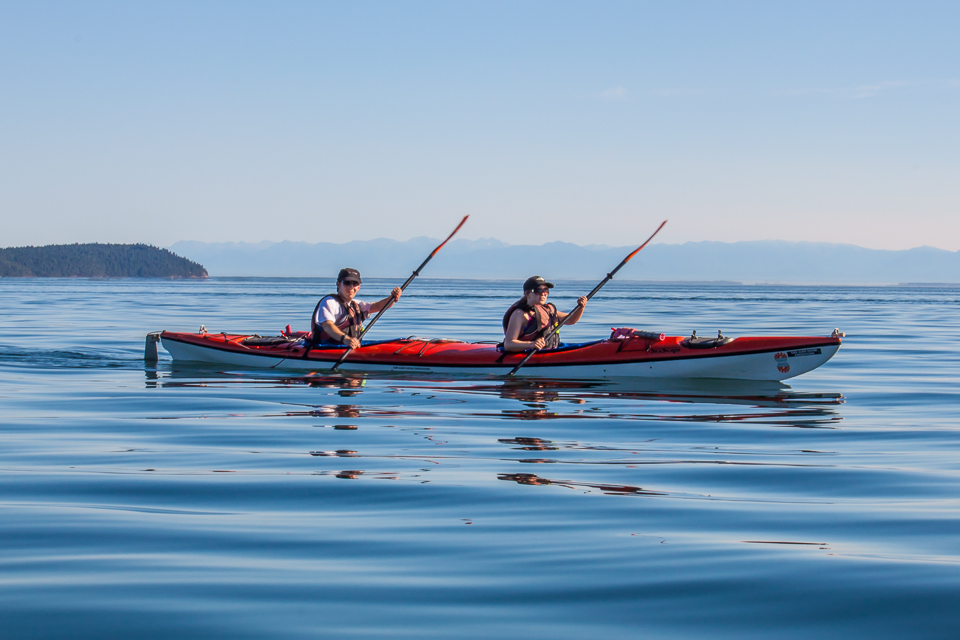
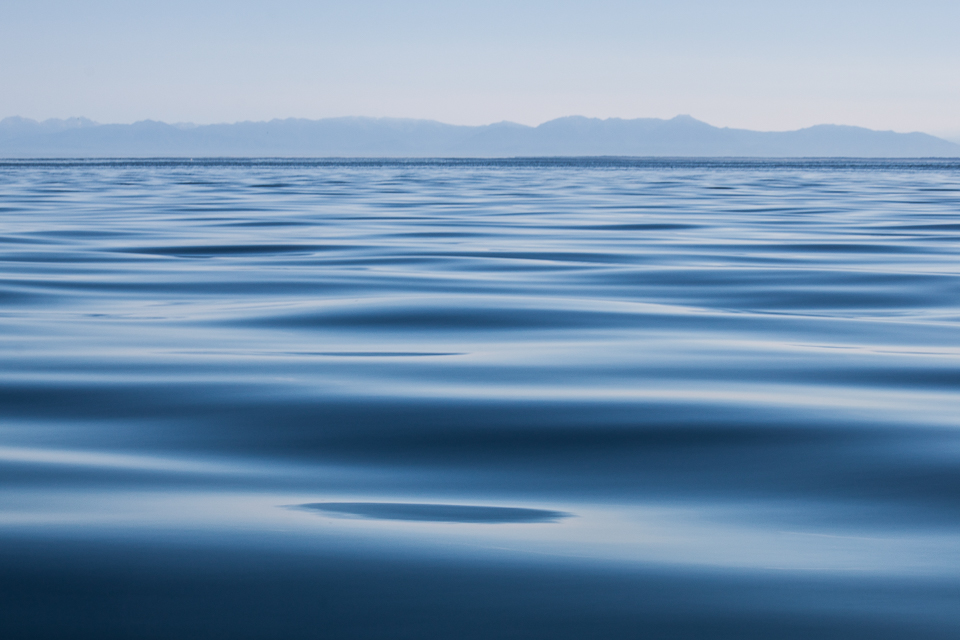
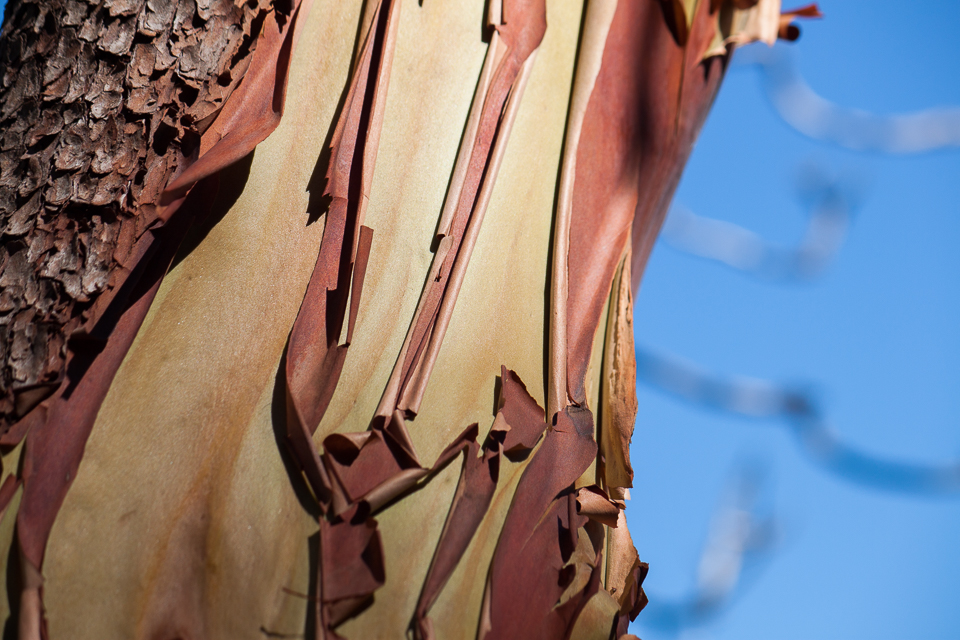
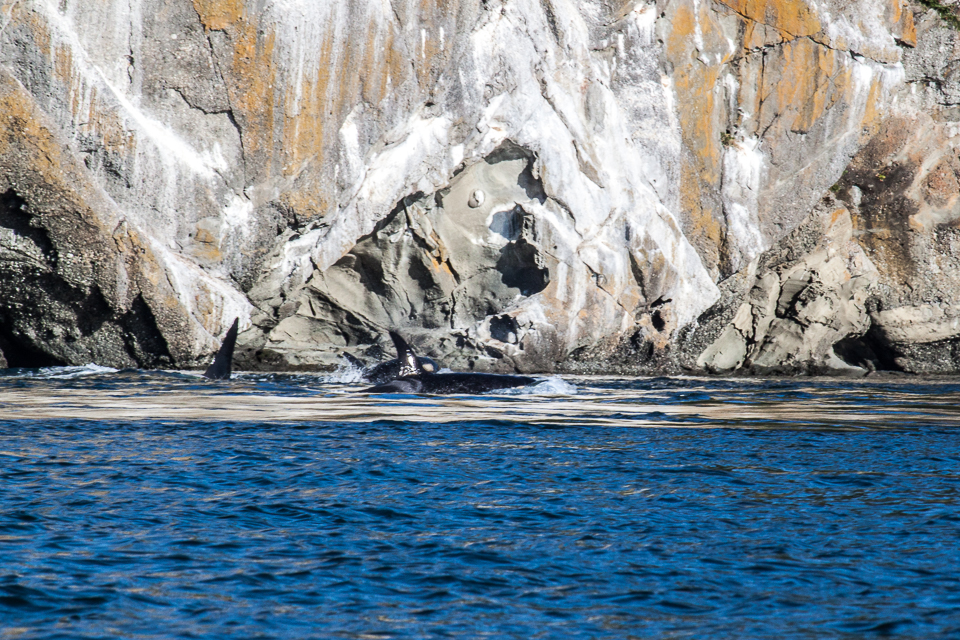
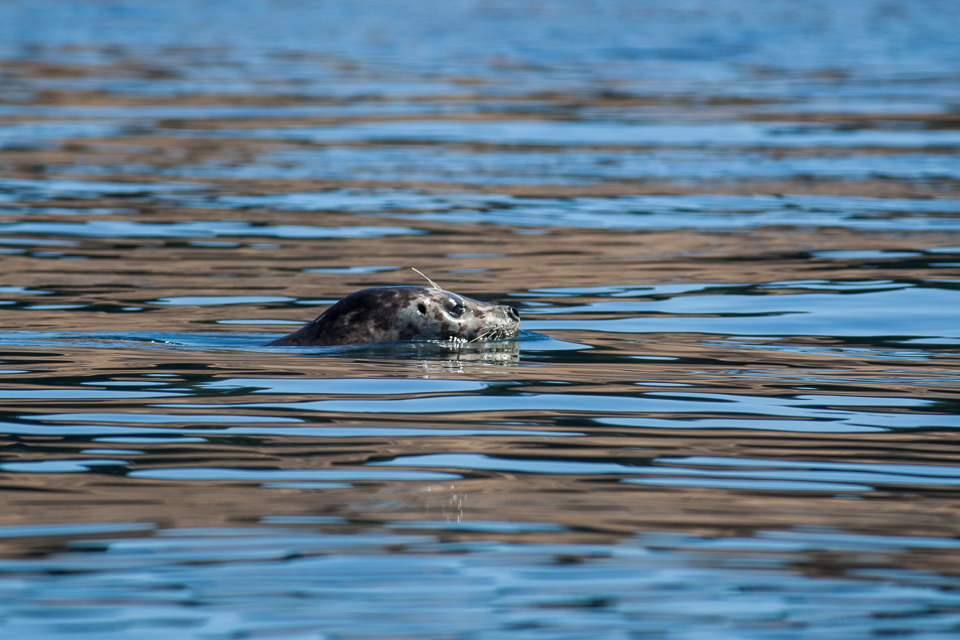
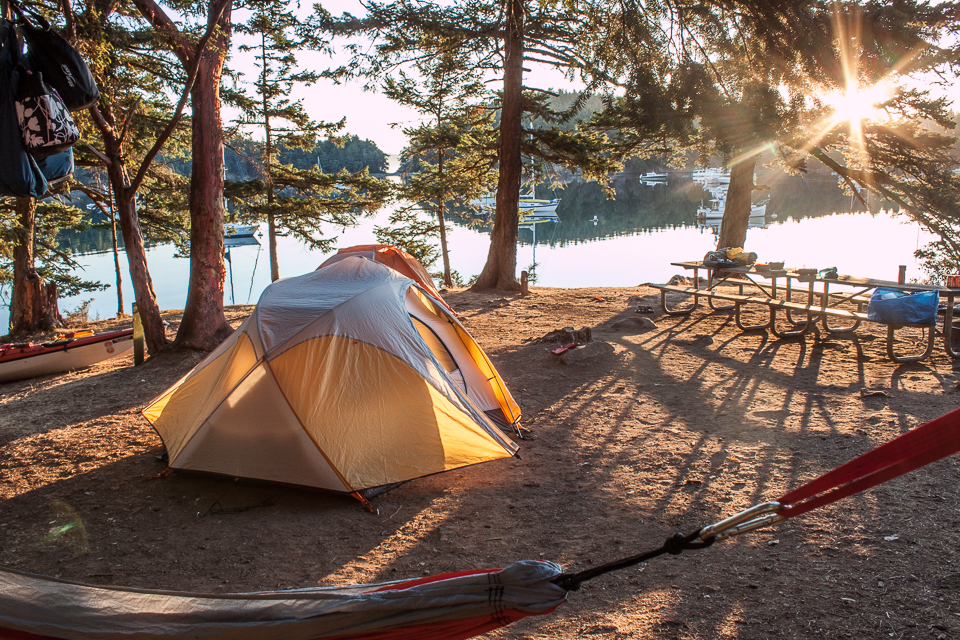
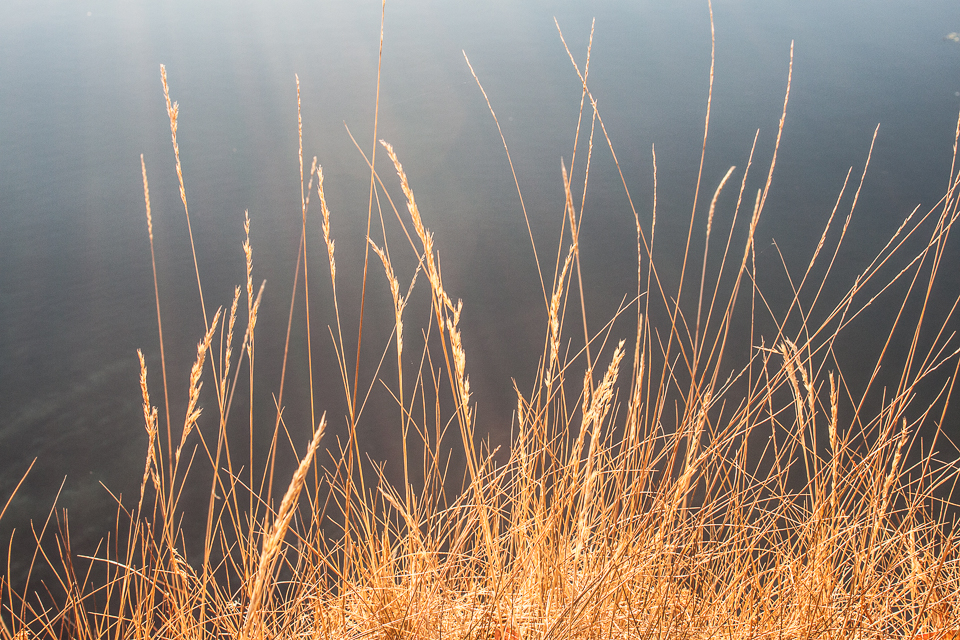
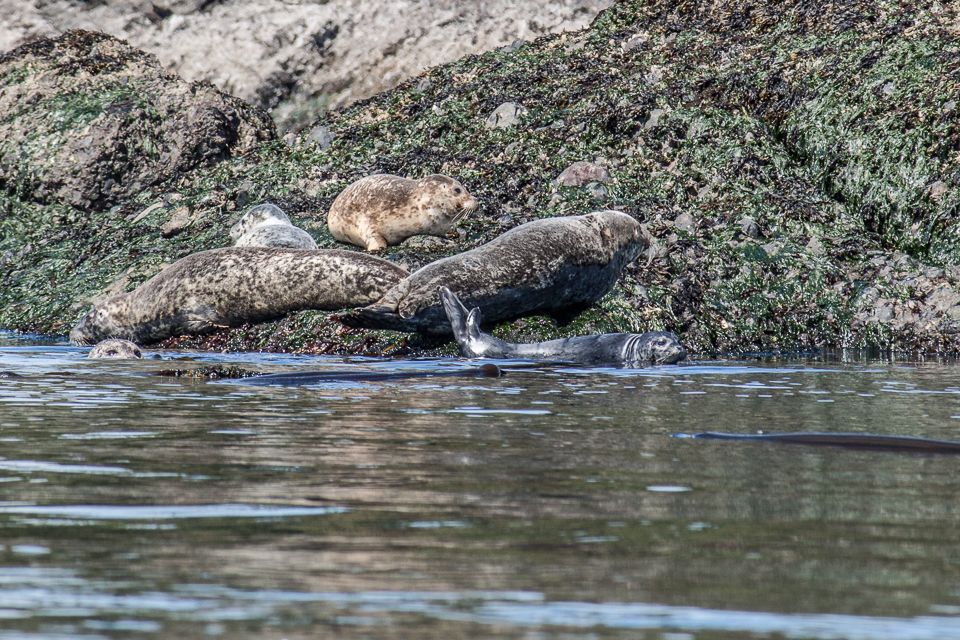
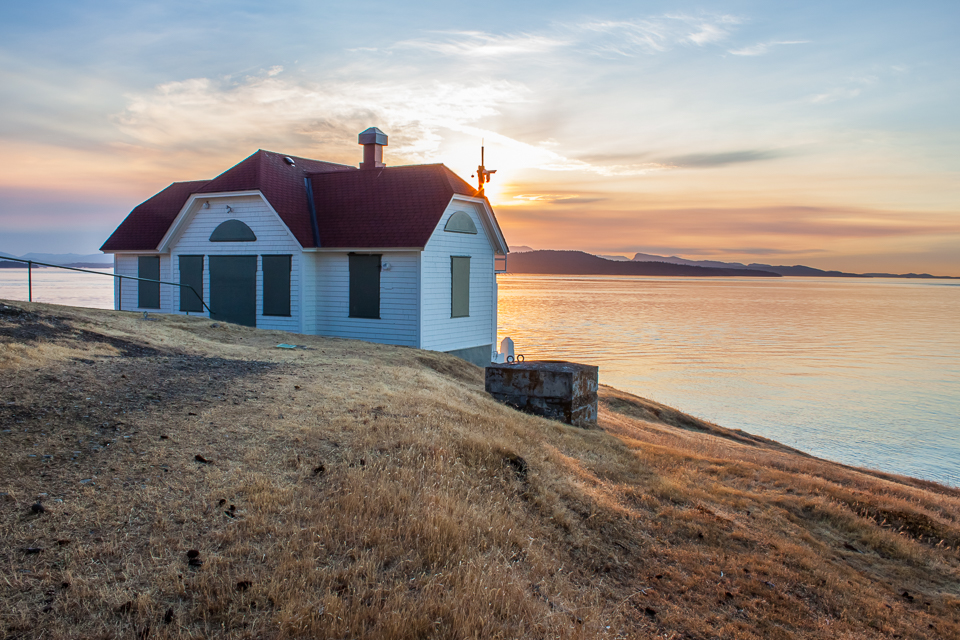
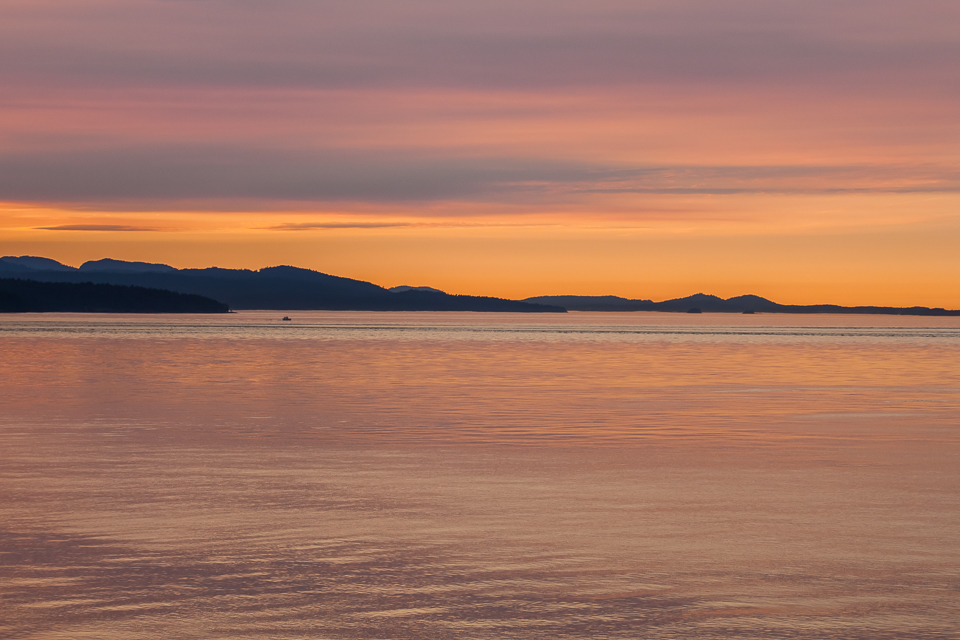
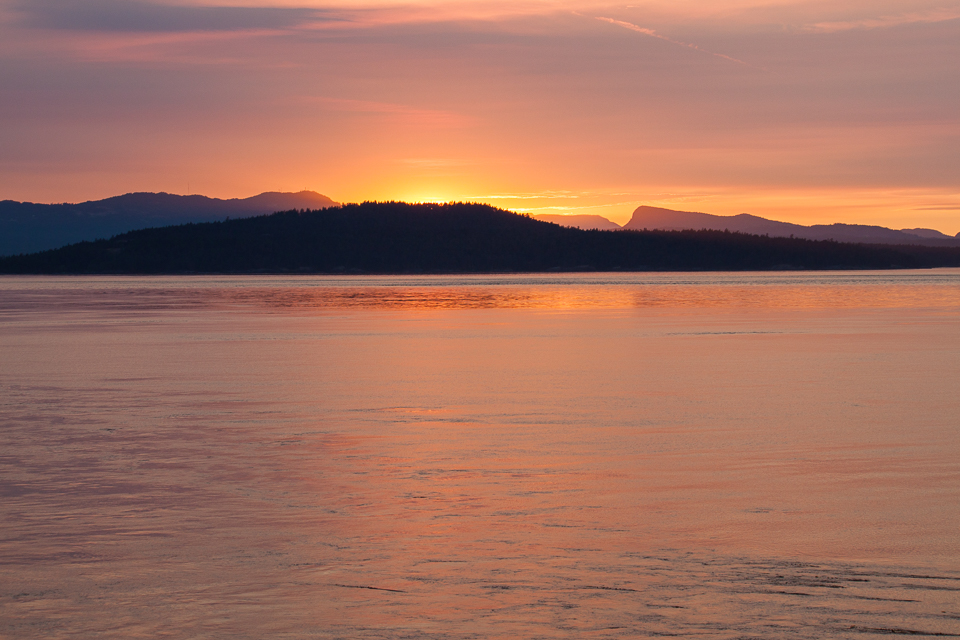
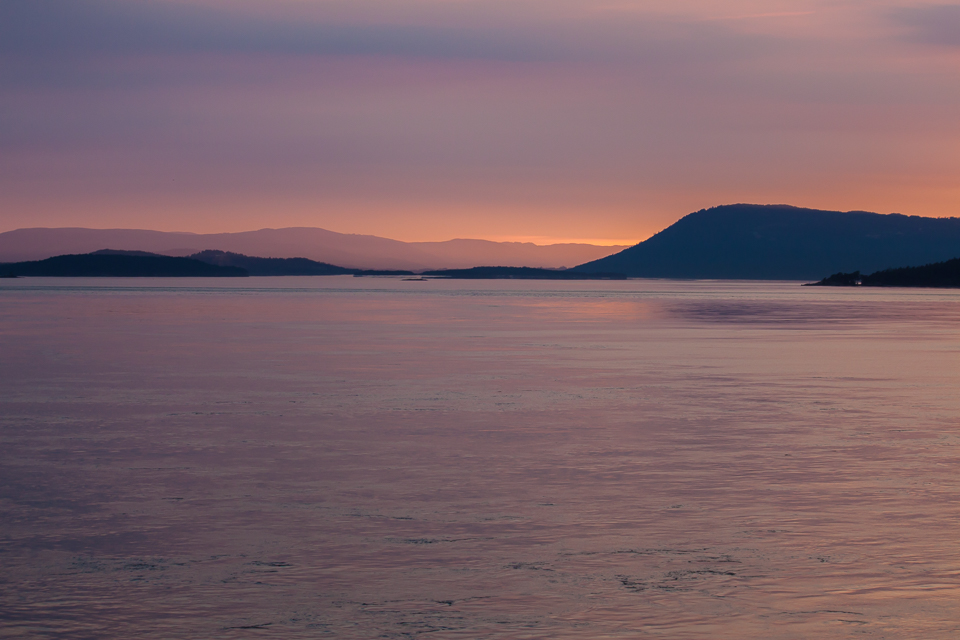
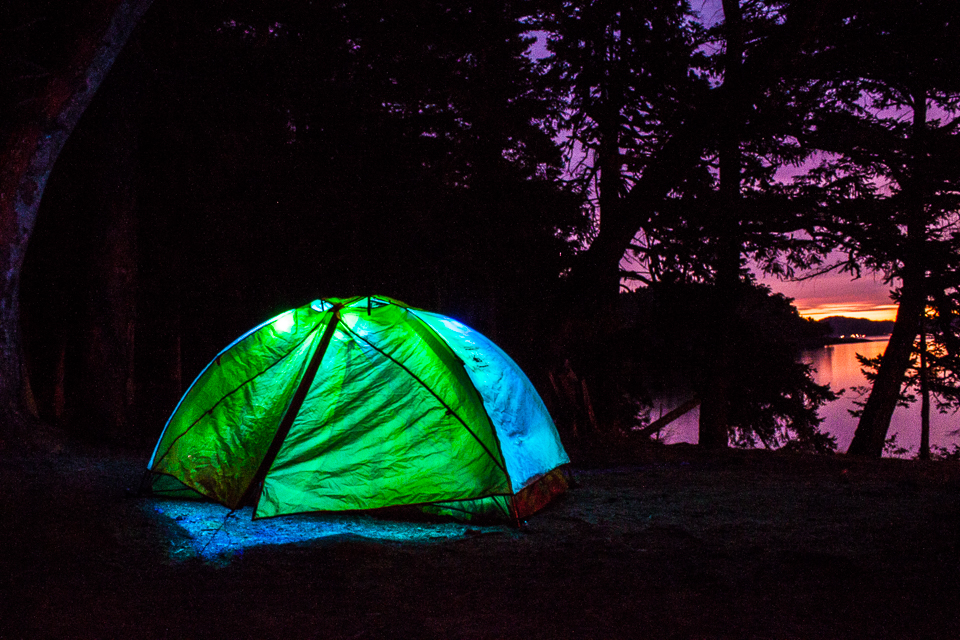

Three Days in the Selkirks
The Selkirk Mountains seem to be a much less explored yet gorgeous section of the state. It doesn't boast the high peaks of the Cascades, but amid the rolling tree covered hills I found it hard to believe I was in Eastern Washington. Douglas Fir, lush creekbeds and wildflowers persisting into mid July made me feel like I was just a few hours from home, though in reality this is a six hour drive from our home.
It also happens to be a wildlife dense area of the state, home to grizzlies, moose, and apparently woodland caribou. We saw evidence of moose tracks, and it was quite a treat to run into a cougar near one of the creeks. He paused for a moment to stare at us before sneaking back into the blueberry bushes.
Our three day trip felt delightfully remote. We didn't run into anyone until we ran into Forest Service workers clearing the trail about a half mile from the trailhead. It was so amazing to be alone in the wild.
Creative High Ground
Brilliant wildflowers, azure skies, dancing clouds and sweeping landscapes can all be found in Paradise.
As inscribed on the steps near the Paradise Visitor Center in Mount Rainier National Park, John Muir in his nineteenth century travels said that the natural gardens that cover Paradise are, “the most luxuriant and extravagantly beautiful of all the alpine gardens I ever beheld in all my mountain-top wanderings.” Today, nature lovers and tourists flock in droves to see these enchanting alpine gardens.
And they leave their mark.
It is here that I get on my soapbox.
The above photograph of my husband Darin was taken at Paradise in August of 2014. I love this photo for many reasons. In a talk I gave to Shorecrest High School’s photography classes I used it to demonstrate compositional elements such as the rule of thirds and the placement of a human subject. Earlier this year Washington Trails Association asked to use this image on a batch of their thank you cards, I assume in part because it has a handsome hiker, a famous mountain, and a well maintained trail as part of its composition. I tell Darin that he is so attractive that one of our favorite outdoor organizations put him on their cards.
But this image saddens me as well. What isn’t apparent until the image is inspected more closely is the evidence of human presence. I’m not referring to my husband, or the trail, but instead the trampling of the garden. As I scanned the ground searching for wildflowers on our late summer evening hike to Panorama Point, I saw smashed plants from feet stepping off trail for whatever reason. I saw picked wildflowers in the hands of those eager to take some of the beauty physically with them. It made me think there is a reason that the ground two meters from the trail has more green than the dirt that lines the trailside. I wish I could see what it looked like when Muir was there.
We’ve seen many more violations of Leave No Trace ethics. Last March at Heather Lake in places the trail was inches deep in mud. When we stepped to the side of the busy trail to put my camera back into my pack, a few hikers shouted, “excuse me” as they walked by us - off trail - to avoid the mud. Darin and I looked at each other and he facetiously said, “I guess they are just widening the trail.” We visited Heather Lake again last Friday and found fireweed picked and thrown onto the trail. On one hike we carried out an entire shredded emergency blanket that we found caught in the bushes. On others, plastic water bottles and Clif Bar wrappers.
Fireweed found picked and thrown aside at Heather Lake
At the Eagle Creek Trailhead in Oregon last April my friend and I saw a couple carrying a large bouquet of wildflowers to their car, essentially removing next year's seeds from the trailside. It is a privilege to hike, especially on beautifully maintained trails. I think this privilege demands respect for the other people who will come afterward.
This is a plea to all those who venture into fragile environments. Please, please respect nature for its power and fragility. Coming down off Ingalls Peak last year we spotted a trio of mountain goats near Lake Ingalls that were being encircled by vultures taking the form of hikers and photographers; phones and cameras out and within arms length of the wild animals. Goats can, have, and will kill people. The hiking trail is not a zoo, nor should it become one.
This is not to say that I have never violated Leave No Trace ethics. I dropped my lens cap on Ruth Mountain and it proceeded to slide down the glacier. I'm sure I've forgotten to secure trash at some point and a wrapper may have blown away. I imagine if a critic followed me around they could find things I do regularly that aren't following Leave No Trace. I see the plank in my own eye, but I will continue to take the creative high ground.
At Ingalls I was fortunate enough to find a goat farther down along the trail, and get this shot from a distance with a zoom lens.
The majesty of nature is what I aim to capture because I value it and want to share that passion. I understand that some of my social media followers follow me for ideas and inspiration for their own photographs. Take the creative high ground. Ultimately, I believe the challenge of getting an ethical shot is so much more rewarding than getting the desperate, damaging shot - rewarding to you, to your clients, to humanity and to nature.
A friend who works for the US Forest Service says that this is why they expend resources to maintain wilderness trails. If there isn't an established trail, people will make many.
Three Traits Photography Has Developed In Me
I was first drawn to landscape photography as a child. My parents are both artists by hobby, and Dad would take me to visit art fairs every summer. Our perennial favorite was the Bellevue Arts Fair, where I always wanted to stop and look at the many gorgeous landscape photography booths.
I never bought anything. A hundred dollar print is out of your price range when your allowance is 50 cents a week and you’re saving up for American Girl doll clothes. But staring at these vibrant images made an impact on me. Spending time looking at those beautiful prints must have contributed to the sort of eye and style I’ve developed.
As I’ve transitioned from being a nine year old with a disposable film camera, to a tween with a reloadable film camera, to a high schooler with a (3.1 megapixel) digital point and shoot camera, to a college graduate with a compact dSLR to now a full frame dSLR, I have learned so incredibly much. The following are three specific traits I think I can accurately credit to my obsession with photography.
Patience
The more I shoot the more I've come to find that landscape photography is much more complicated than just being in the right place and then pointing and shooting. The more I do it the more I appreciate the effort. It's easy to get a few lucky shots when you're in the right place at the right time, and I definitely do. Everyone will. As my husband likes to quote, “A camera in the hand is worth two in the pack.” This is definitely true in many cases.
Consistently getting great shots time and time again, however, is another story. I don't necessarily get a winner every trip. So much goes into scouting and waiting for the right light, the right clouds, and the right season.
By nature I’m not an incredibly patient person. My husband politely describes me as “efficient” and by this he means I don’t put much effort into something unless I think it’s necessary. So basically I get things done very quickly and only to quality level I deem necessary. You should see the difference between how we pack our backpacks. He’s so methodical and diligent. I sort of throw stuff in there.
With photography, especially fine art photography, mere efficiency really can't make the cut. Especially with my printed art, I am constantly looking for ways to make it better, whether by better materials, a different medium, a different printer, a more creative presentation, the list goes on. The art forces me to slow down and get lost in it.
Respect
Respect for People
I've watched photographers nearly get into fights. I'm not kidding. At Rialto Beach, Darin and I were sitting on some rocks, waiting for good sunset light, and across the rocks on the beach a photographer had set up to shoot the silhouette of one of the seastacks. Along came another photographer who planted himself directly between the first photographer and his subject. The waves drowned out the conversation, but judging by their body language it was an altercation. We were wondering when they would start throwing punches. Thankfully the second guy moved on.
Rialto Beach
I'm slightly ashamed to admit (if you know me personally I rarely raise my voice) that at Mesa Arch in Utah I raised my voice at a tourist who was shoving their iPad in front of my lens and in the process knocked my tripod over. My camera probably would have broken had I not caught it as I fell.
Mesa Arch, THE classic photography spot in Canyonlands National Park
There definitely are vibes certain photographers send out, sometimes quite overtly, that they are ticked off that so many other photographers are around. I understand this. We have this goal of getting “the best” shot of something and it annoys us when we are copied or won't have the only shot of something.
Landscape photography is a ridiculously competitive field for those of us that market our work, so we’re always looking for something beautiful and unique. Sometimes I find an incredible spot, post a picture, and then get several messages from people with a profile picture of themselves behind a camera asking me where exactly it was. I figure they’d want the GPS coordinates if I had them. I will give the trail or area out of respect and trying to not appear stingy, but exploring is part of the challenge and part of the art. I get annoyed when people set up right next to me to copy my shot on a large beach where I’m sure there are other angles. I’m not perfect.
But I try to keep in mind when I’m getting frustrated with people the words of astrophotographer Brad Goldpaint when we ran into him in Arches National Park, “Life is too short for that.” Ultimately treating them as people and not just as an annoyance is the healthy, mature, professional, respectful way to go.
Respect For Nature
Nature is powerful and should be respected as such. Nature is fragile and should be respected as such. Nature is my favorite subject, whether a mountain, river, wildflower or waterfall. Growing up, most of the family vacations we took were to national parks, with my parents being very intentional about developing in my brother and I an appreciation for nature. We did Disneyland once to say we did it. My fondest memories however are of seeing a moose in the Tetons, watching a nursing bison calf in Yellowstone, going for a horseback ride in Glacier National Park, and waking up before the rest of my family just outside Zion National Park to step outside and see massive sunlit red cliffs. We had arrived at our motel in the dark and had no idea how majestic a cathedral we had just slept in.
A friend who works for the forest service likes to say that this is why they maintain wilderness trails. If there isn't a defined trail, people will make many.
Too often when we are out hiking we find evidence that nature has been disrespected. Often, photographers are to blame. Earlier this year a high profile outdoor equipment company published an image by a professional photographer featuring a campsite pitched directly on alpine wildflowers. They glorified it because it looked awesome. Yes, it looked awesome. It looked awesome because up to that point no one had camped there. Up until that point visitors had respected the fragility of those plants and hadn’t trashed them. It broke my heart knowing thousands of people were seeing this and I worried some would be inspired to repeat that mistake just to get a shot like that.
Mountain goat at Lake Ingalls, shot from a distance.
Nature is powerful. For the same reason that I refuse to take portraits on railroad tracks, there are some nature shots I will not try to get. I love thunderstorms, but I do go to unsafe places to shoot them. Many shots I see look to be taken from viewpoints on hills, probably on a metal tripod. I just won’t do that.
I will not approach wildlife. Coming down off Ingalls Peak last year my husband and I spotted a mountain goat herd near popular Lake Ingalls being encircled by several vulture hikers and photographers. They had their phones and cameras out at and were within arms reach of these poor goats. Goats can, have, and will kill people. The hiking trail is not a zoo. I did get a goat shot further down the trail. The goat was at a distance and I used a zoom lens.
Tenacity
I have (and do) have dry, discouraging months where I don't sell a single print. But then the next month I’ll sell several. I don’t live solely off photography (not even close) but I love it enough that during those dry months I still enjoy shooting. I think this comes from the inherited artist side of me. There’s so much satisfaction in creating and sharing that it gets me through the frustrations of not being able to afford better equipment or software.





































